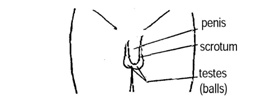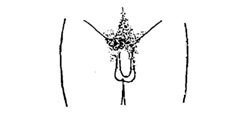Protocol - Assessment of Pubertal Development - Teenage Male
Description
The male participant uses the Tanner staging drawings to self-assess the stage of puberty he has reached in terms of the size and shape of his testes and his pubic hair.
Specific Instructions
Please use the appropriate male or female specific protocols.
From the Avon Longitudinal Study of Parents and Children (ALSPAC):
We would like to assess the stage of your physical development using the drawings on the next pages. These show various stages commonly used by doctors to assess the growth and development of boys. We need to know which drawings most closely match your stage of development at the moment. Not all teenagers follow the same pattern of development. Just pick the stage that is closest, based on both the picture and the description.
The Sickle Cell Disease Genitourinary Working Group notes that patients and research participants with chronic diseases, like sickle cell disease, can have a delay in the start of puberty and with that relative short stature. Investigators should track height and stage of puberty carefully as the participant enters adolescence
Availability
This protocol is freely available; permission not required for use.
Protocol
Avon Longitudinal Study of Parents and Children (ALSPAC), Growing and Changing, Male Teenage Questionnaire
We would like to assess the stage of your physical development using the drawings on the next pages. These show various stages commonly used by doctors to assess the growth and development of boys.
Not all teenagers follow the same pattern of development.
Just pick the stage that is closest, based on both the picture and the description.
Teenagers go through the various stages of physical development at different ages. Some start as early as 6, others not until they are 20. We need your help in letting us know what stage you are at. Please look at each of the drawings. It is also important to read the descriptions.
Cross the box that is closest to your current stage
|
| 1 [ ] | The size and shape of the testes, scrotum (the sac holding the testes) and penis are about the same as when you were younger. |
|
| 2 [ ] | The penis is a little bit bigger. The scrotum has dropped and the skin of the scrotum has changed. The testes are bigger. |
|
| 3 [ ] | The penis has grown longer, the testes have grown and dropped lower. |
|
| 4 [ ] | The penis is longer and wider. The head of the penis is bigger, the scrotum is a darker colour and bigger. The testes are bigger. |
|
| 5 [ ] | The penis, scrotum and testes are the size and shape of a man’s. |
As part of development, at some stage hair will start to grow just above the penis.
Please look at each of the drawings. It is also important to read the descriptions.
Cross the box that is closest to the amount of pubic hair that you have.
|
| 1 [ ] | There is no hair at all. |
|
| 2 [ ] | There is a little soft, long, lightly coloured hair at the base of the penis. It may be straight or a little curly. |
|
| 3 [ ] | The hair is darker and more curled. It has spread out and thinly covers a bigger area. |
|
| 4 [ ] | The hair is as dark and curly as that of a man, but it hasn’t spread out to the legs. |
|
| 5 [ ] | The hair is like that of a man. It has spread out to the legs. |
Personnel and Training Required
None
Equipment Needs
Pencil and paper
Requirements
| Requirement Category | Required |
|---|---|
| Major equipment | No |
| Specialized training | No |
| Specialized requirements for biospecimen collection | No |
| Average time of greater than 15 minutes in an unaffected individual | No |
Mode of Administration
Self-administered questionnaire
Lifestage
Child, Adolescent, Adult
Participants
Males aged 14-20 years
Selection Rationale
The Avon Longitudinal Study of Parents and Children (ALSPAC) provides Tanner stage drawings that have been widely used for decades with adolescent males and females to determine their own perceptions of pubertal development.
Language
Chinese, English, Spanish
Standards
| Standard | Name | ID | Source |
|---|---|---|---|
| Logical Observation Identifiers Names and Codes (LOINC) | Assess pubertal dev male proto | 62645-7 | LOINC |
| Human Phenotype Ontology | Puberty and gonadal disorders | HP:0008373 | HPO |
| caDSR Form | PhenX PX100102 - Assessment Of Pubertal Development Male | 5970500 | caDSR Form |
Derived Variables
None
Process and Review
The Expert Review Panel #5 (ERP 5) reviewed the measures in the Reproductive Health domain.
Guidance from ERP 5 includes:
• No significant changes to measure
Back-compatible: no changes to Data Dictionary.
The PhenX Sickle Cell Disease Genitourinary Working Group (WG) reviewed this protocol in May 2022. Guidance from the WG includes:
- Updated Specific Instructions
- Clarified Protocol Source
Protocol Name from Source
Avon Longitudinal Study of Parents and Children (ALSPAC), Growing and Changing (8), Male Teenage Questionnaire
Source
University of Bristol. Department of Social Medicine. (n.d.). Avon Longitudinal Study of Parents and Children (ALSPAC). Growing and Changing, Male Teenager Questionnaire. Oakfield Grove, Bristol, UK: Author. Questions B1-B5 and C1-C5.
Certification for the Spanish translation can be found here.
General References
August, G. P., Grümbach, M. M., & Kaplan, S. L. (1972). Hormonal changes in puberty. 3. Correlation of plasma testosterone, LH, FSH, testicular size, and bone age with male pubertal development. Journal of Clinical Endocrinology and Metabolism, 34(2), 319-326.
Burr, I. M., Sizonenko, P. C., Kaplan, S. L., & Grümbach, M. M. (1970). Hormonal changes in puberty. I. Correlation of serum luteinizing hormone and follicle stimulating hormone with stages of puberty, testicular size, and bone age in normal boys. Pediatric Research, 4(1), 25-35.
Jost, A. (1970). Hormonal factors in the sex differentiation of the mammalian foetus. Philosophical Transaction of the Royal Society B Biological Sciences, 259, 119-130.
MacLaughlin, D. T., & Donahoe, P. K. (2004). Sex determination and differentiation. New England Journal of Medicine, 350(4), 367-378.
Marshall, W., & Tanner, J. M. (1970). Variations in the pattern of pubertal changes in boys. Archives of Disease in Childhood, 45, 13-23.
Raivio, T., Falardeau, J., Dwyer, A., Quinton, R., Hayes, F. J., Hughes, V. A., Cole, L. W., Pearce, S. H., Lee, H., Boepple, P., Crowley, W. F., Jr., & Pitteloud, N. (2007). Reversal of idiopathic hypogonadotropic hypogonadism. New England Journal of Medicine, 357, 863-873.
Protocol ID
100102
Variables
Export Variables| Variable Name | Variable ID | Variable Description | dbGaP Mapping | |
|---|---|---|---|---|
| PX100102_Male_Pubic_Hair_Development_Stage | ||||
| PX100102020000 | Cross the box that is closest to your more | Variable Mapping | ||
| PX100102_Penis_Scrotum_Testis_Development_Stage | ||||
| PX100102010000 | Cross the box that is closest to your more | Variable Mapping | ||
Measure Name
Assessment of Pubertal Development
Release Date
February 26, 2010
Definition
Separate male- and female-specific protocols to assess stage of puberty. Stage of puberty can be assessed by pubic hair, female breast development, and the size and shape of the male testes.
Purpose
The purpose of these protocols is to assess stage of puberty.
Keywords
Reproductive health, puberty, breast development, testes development, Tanner staging, Avon Longitudinal Study of Parents and Children, ALSPAC
Measure Protocols
| Protocol ID | Protocol Name |
|---|---|
| 100101 | Assessment of Pubertal Development - Teenage Female |
| 100102 | Assessment of Pubertal Development - Teenage Male |
| 100103 | Assessment of Pubertal Development - Child and Adolescent Female |
| 100104 | Assessment of Pubertal Development - Child and Adolescent Male |









